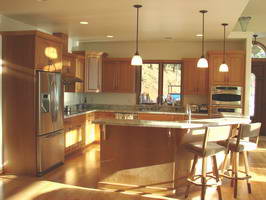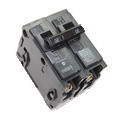Upgrading Home Electrical Wiring
 '; ';
|
How to Upgrade Knob and Tube Electrical Wiring: Installing New Electrical Wiring in an Older Home. © By: Dave Rongey |
Replacing Old Home Wiring
Electrical Question: I have purchased an old house I know there is old knob and tube wire and plan to replace it.
- This Old House Was Built in 1928
My plan is to have a certified electrician install a 200Amp service so that I can slowly (while learning) move my rooms and connections from the old 100amp service that is in place now, eventually completely removing the old service and the old wire mis-mash that currently exists. I have seen Knob and Tube cloth wrapped, intermingled with some updated runs for specific appliances (like the stove, other major appliances and some specific computer outlets). - Rewiring Project for the Old House
I have gotten quotes to have the entire thing professionally done and it is way out of my price range, plus all the quotes state that the quote does not include repair to walls and ceilings that will damaged as new runs are put in place – we will need to absorb that as well. This has led me to my current plan of having pro’s install service and I will try and do the run’s while maintaining as much of my antique walls and ceiling as possible. Which leads to my question – I have a very open attic, as well as a basement. - Evaluating the Existing Circuits
I am wondering if I cannot have all the upstairs fed from the attic (and a single run from the basement to the attic) and all of the first floor serviced from the basement. Would I need a breaker box in both locations? One up in the attic and one in the basement & should I have the pros set this up at the same time – so that I can then make the runs to the individual rooms from the professionally installed service? - Working with the Existing Structure of the Home
And finally to help save my walls and ceiling (all which are Plaster and lath – with some having an added layer of sheet rock on top – which I have learned is impossible to navigate with original means (stud finders, magnetic cable runners etc.) would it be a horrible or impossible idea to route out a cable path in the lath and plaster and sheet-rock with a router deep enough to house the cable, but not deep enough to penetrate the lath and then just re-plaster over the cable – encasing it in the plaster in the walls?
This electrical wiring question came from: David, from Macomb, Illinois.
Dave’s Reply:
Thanks for your electrical wiring question David.
Installing New Electrical Wiring in an Older Home
Application: Rewiring an Old Home.
Skill Level: Intermediate to Advanced. This electrical project is best performed by a Licensed Electrician or Electrical Contractor or Certified Electrician.
Tools Required: Electricians Pouch of Hand Tools for Rough-In Wiring, Electric Drill and Auger Bits, Extension Cords, and Ladders.
Safety: All personal safety measures must be taken when performing remodel projects where you may come into contact with hazardous materials and environmental contaminants such as fiberglass insulation, vermiculite and asbestos, molds or mildew, as well as dust.
Estimated Time: Depends on the extent of the project, the type of wall coverings and structural construction and available access to the project area.
Precaution: Any existing wiring in the immediate area that may interfere with the installation should be identified and turned OFF and Tagged.
Notice: Installing additional electrical wiring or upgrading existing electrical circuits and wiring should always be done according to local and national electrical codes with a permit and be inspected.
How to Upgrade Knob and Tube Electrical Wiring
- Planning the Electrical Wiring
There are several methods of installing home electrical wiring that can me used, however each method must be done according to code and with a permit and inspections. If there are problems concerning access then it is possible to install surface conduit to safely enclose the new electrical wiring. - Upgrading Old Wiring
When upgrading the electrical wiring of an older home the dwelling space or square footage should be treated as if it were a new home where all of the current electrical codes would apply. The project could be done a little at a time, area by area, but it would be best to begin by upgrading the electrical service panel. - Dealing with Wall Coverings
When dealing with the wall coverings to obtain access to install the new electrical wiring you must consider the time and labor costs to save the existing walls and fish in the wire verses having a crew of laborers remove the existing sheet rock or lath and plaster. - Opening the Walls Up
Having the walls open enables you or the contractors to have full access to remove all the old electrical wiring and boxes and start fresh with new materials located conveniently and according to code. You will also have the opportunity to inspect the plumbing and any other utilities and the structure and make changes or upgrade as needed.
More about Upgrading Home Electrical Wiring
- Listing of electrical codes for services with examples of electrical services codes for home electrical wiring.
- Electrical Codes For Electrical Service Panels
- A guide to home electrical circuit breakers and how they work to protect your electrical wiring. When properly installed, your home electrical wiring is protected by a circuit protection device.
- Electrical Circuit Breakers and Fuses
- A visual guide to home circuit breakers and the home electrical panel system.
- Home Circuit Breakers
- Electrical Wiring Question How do you know when to use 12-2 versus 12-3, 14-3 versus 14-2. I keep on getting confused on when to use 2 wire versus 3 wire.
- 2 Wire and 3 Wire Cables
The following may also be helpful for you:
|
|
Be Careful and Be Safe - Never Work on Energized Circuits!
Consult your Local Building Department about Permits and Inspections for all Electric Wiring Projects.
More articles about Electrical Wiring, Home Wiring, upgrade knob and tube wiring, wiring upgrade and Home Electrical Wiring: |
|
| « Previous | Next » |
Installing Floor Heat Electrical Wiring |
UK 220 Volt Electrical System |

















